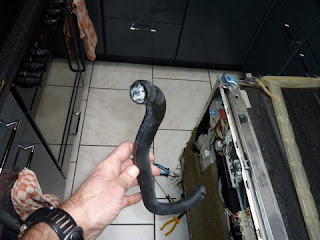It's been a long time since I've blogged, but I thought I'd share this recent adventure with you.
Background
Our 17 year old (presumably, that's the age of the house) dishwasher (ATAG S6M22A) stopped washing recently (typically on the day before we needed it most, we were hosting a dinner). More specifically, no water entered the machine.
First analysis
Hoping for a simple solution, I hoped that the (external) water stop had failed. Me being me, I took it apart (as far as possible without demolishing it) and eventually concluded that, yes, no water was passing through the water stop. (Unfortunately, I have no pictures of this part of the adventure).
I was on the verge of buying a new one (still hoping that this was the problem), but fortunately I phoned a local hardware store and was given some good advice, which called for a new appraisal of the problem.
I was told to test the water stop by connecting it to the mains. (I thought it had a 12V supply as I'd noticed small voltages, but this turned out to be residual currents and the water stop itself needs a 230V supply). (Typically, I hadn't found any information on the water stop on the internet). As I'd already taken it apart, connecting up to the mains was easy .. and proved that the water stop did work (water flowed into the dishwasher).
Ergo, the problem was deeper .. why wasn't the water stop receiving power ?
Interbellum
The failure of the dishwasher provoked thoughts of replacing the now tired kitchen. However these are expenses not yet planned for. Another option was to replace only the dishwasher (first or second hand). The friendly hardware store had given the advice to forget about repairing this one .. it just wasn't worth it ..
Second analysis
This involved looking inside the "machine room" of the dishwasher. The first step was to remove the plinth at the bottom of the dish washer. Once I'd done this, I noticed that the "machine room" of the dishwasher had a substantial amount of water in it.
Removing the water (awkwardly), the dishwasher worked again. I.e., there was a sensor which stops the water flow when flooding is discovered (how clever). So, now we could use the dishwasher .. but after each use, we had to remove the flooding. Not ideal and I hadn't discovered the leak.
So .. last Saturday, I just did it (instead of thinking about it too long). Together with Timothy, I moved the dishwasher out of its enclosure. This proved to be awkward as the tiled floor in the kitchen, had been laid after the dishwasher was placed. The dishwasher had to be dropped about an inch (by adjusting 4 screws in all corners (lying on my stomach and managing to use only a small stroke of my (10) spanner) which took quite a time. We then got it out and removed the side panels for a better view.
 |  |
Switching the dishwasher on again was fascinating, watching the water flow in the reservoir (right picture above). After peering at the "machine room" for a while, I finally discovered the (real) origin of the leak, a worn out rubber tube (see picture right, below).
 |  |
Now to replace the worn out tube .. I kind of hoped, I'd be able to walk into a local store and find a replacement tube (1", which I'd have to cut to size). Unfortunately, this wasn't the case .. and because I didn't want to order a part and wait, I decided that any flexible tube with the right diameter would do. The best thing I found was a washing machine drain pipe.
 |  |
Unfortunately, it was way to long (150cm vs. 40cm). The result was that it had to be coiled around in an empty space (see picture left, below).
 |  |
Unfortunately, this solution didn't work. It caused the reservoir to overflow, when filling the dishwasher .. I can only think, that air-locks formed, stopping the free flow of the water.
I now had to think of a way to shorten the tube .. but unfortunately, these tubes are made to be shortened, they have rubber connections at either end which are welded to the flexible (plastic ?) pipe. The solution was obvious .. I had to reuse the original tube (a good bit) to fit over the flexible pipe (see picture right, above and picture below). It was a nice tight fit, but to be on the safe side (..) I covered the outside of the flexible pipe with a silicon kit to form a really watertight and glued connection.
 |
And guess what, the dishwasher works again .. eureka !
Conclusion
I get a kick out of repairing written-off machines, so this was great.
Costs: a washing machine drain pipe (EUR 6,50), some silicon kit and a few hours of mucking about (and a few hours of my darling's patience).
Benefits: a big smile.
1 comment:
Good News! Congratulations, it just shows that persistence pays (but not always! which is one of lifes annoying paradoxes) Well done, enjoy your success. Ciao Googoo
Post a Comment